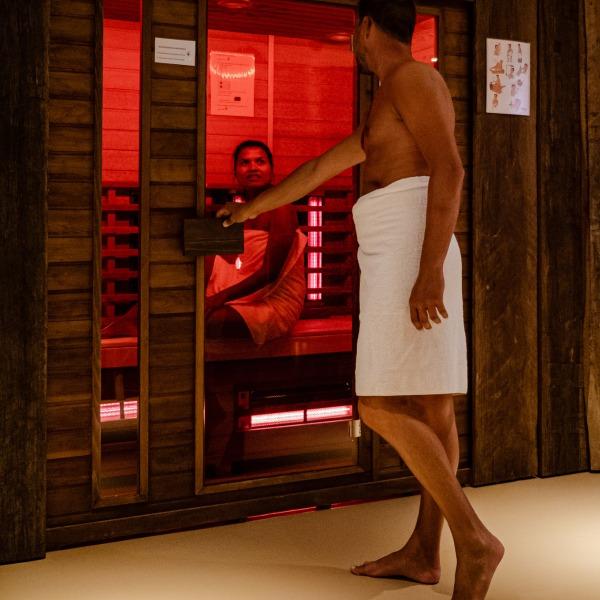Sauna is a form of heat therapy that is becoming increasingly popular because of its wide range of health benefits.
In this beginner’s guide, we’ll explore the basics of sauna and heat therapy, how to use them safely, how to incorporate them into your routine, and how to choose the right sauna for your needs.
What is Sauna Heat Therapy?
Heat therapy is the practice of using heat to promote healing and immunity. It has been used for centuries in many cultures around the world.
While there are many types of heat therapies including hot stone therapy, heat pads, and heat wraps, in this article, we will be focusing on sauna as it has been proven to be highly effective.
There are different types of saunas, including traditional saunas, infrared saunas, and steam rooms.
Traditional saunas are a form of heat therapy that uses dry heat to warm the air and increase the body’s temperature. Advances in technology have led to the development of infrared saunas which use infrared light to heat the body directly, without warming the air. Steam rooms use moist heat to create a humid environment.
What are the Benefits of Sauna?
Sauna therapy has numerous health benefits such as improved circulation, relaxation, and detoxification.
Additionally, it aids in weight loss, pain relief, skin health, reducing inflammation, and significantly improving the immune system. Moreover, sauna is an effective stress-reliever and promotes better sleep.
When the body is exposed to heat stress, such as in a sauna, it triggers a heat shock response that leads to the production of heat shock proteins (HSPs). These proteins help protect cells from damage caused by heat stress and other stressors.
Heat shock proteins are also involved in reducing inflammation and oxidative stress in the body. Sauna use has been shown to reduce markers of inflammation and oxidative stress in the body, which can help protect against chronic diseases such as heart disease and diabetes.
According to a study published by the National Institutes of Health:
Frequent dry sauna improves a variety of health factors including reduced overall mortality rates related to cardiovascular issues and dementia. There’s lots of evidence that supports sauna’s effects on promoting cardiovascular health as well as rheumatic diseases such as arthritis, fibromyalgia, and chronic fatigue.
Source: NIH
In addition, saunas have been shown to have potential benefits for cardiovascular health despite being a passive activity. The heat from the sauna can help to increase heart rate and improve blood flow, which can help to lower blood pressure and improve overall cardiovascular health.
Learn more about sauna and heat therapy benefits in this short video with Andrew Huberman, a research scientist that studies human optimization:
Dr. Andrew Huberman, a neuroscientist, and Dr. Rhonda Patrick, a biomedical scientist, are both proponents of sauna. According to their research, the most notable benefits of sauna use include:
- Enhanced Stress Resilience: Sauna use can increase heat shock proteins that help in cellular repair processes, potentially leading to improved stress resilience.
- Improved Brain Function: Regular sauna use may promote neurogenesis (the growth of new brain cells) and improve cognitive function.
- Cardiovascular Health: Sauna use has been associated with improved cardiovascular function, including better blood pressure and arterial health.
- Longevity: Both experts have cited studies suggesting that regular sauna use is associated with a reduced risk of all-cause mortality. For instance, a study mentioned by Dr. Huberman on his Huberman Lab podcast indicates that frequent sauna use (4-7 times per week) may cut all-cause mortality by 50%.
Dr. Rhonda Patrick has also highlighted the role of sauna use in increasing the production of growth hormone, which has various beneficial effects on muscle maintenance and overall health.
How to Safely Use a Sauna
Before stepping into a sauna, make sure to be well hydrated.
When using a sauna, start with short sessions and gradually increase the time and temperature. It may take a while for you to get acclimated to the heat.
In general, the recommended time limit for a sauna session is between 15-20 minutes, with a recommended temperature range of 150-190 degrees Fahrenheit. Aim to use the sauna 2-3 times per week for promoting general wellness.
Biomedical researchers, like Andrew Huberman, offer multiple sauna protocols depending on which aspect of your health you wish to optimize.
For example, if you wish to use sauna heat therapy to optimize your cardiovascular health, Dr. Huberman recommends this protocol:
When using sauna to optimize cardiovascular health, stay in the sauna for about 5-20 minutes per session, heated to around 176-212ºF. Do this 2-3 times per week or as much as 7 days a week if possible. The more often you can get in the sauna, the better it is for your cardio.
Source: Huberman Lab
After a sauna session, it’s essential to rehydrate and cool down. This can be achieved by drinking water and taking a cool shower or dip in a pool. If you have access to a cold plunge – even better!
Choosing the Right Sauna or Heat Therapy for You

When choosing the right sauna for heat therapy, it’s important to consider your budget, lifestyle, and health goals.
If you have the room and it’s within your budget, nothing beats having a personal sauna to use regularly from the comfort of your home.
If you don’t have the extra space for a sauna or if it’s not within your budget, check if your local gym has a sauna. Signing up for an affordable gym membership is a great way to gain access to saunas for frequent use.
Popular health club chains like LA Fitness gyms, which are in every major city in California, all of have saunas. These gym memberships are affordable with a price tag of about $40 per month. At less than $2 per day, that’s a huge investment and well worth it for improving your overall wellbeing.
In most cases, a portable infrared sauna is the way to go. It’s affordable, convenient, and easy to set up.
When considering saunas, there’s typically three main types:
- Traditional sauna
- Infrared sauna
- Steam sauna
Traditional Saunas
Traditional saunas are a type of sauna that use dry heat to create a hot and slightly humid environment. These saunas have been used for centuries and are typically made of wood and heated with a stove or heater that heats rocks to create the heat.
Traditional saunas are the most common and widely available at many gyms and health clubs. These saunas are made out of wood. They can be expensive to install and maintain. They can take up a lot of space and take a long time to heat up. There’s also smaller, personal sized saunas that can fit one or two people.
Traditional saunas are typically heated to a temperature of around 160-200 degrees Fahrenheit, with a humidity level of around 10-20%. The heat from the sauna causes the body to sweat, which can help to eliminate toxins and improve circulation.
Infrared Saunas
Infrared saunas are a type of sauna that uses infrared heaters to emit infrared light that is absorbed by the body, rather than heating the air like traditional saunas.
This type of sauna is becoming increasingly popular because it’s affordable and there’s lots of portable options. They heat up quickly, usually taking around 10 minutes to reach your desired temperature.
Infrared saunas are typically heated to a lower temperature than traditional saunas, ranging from 120-160 degrees Fahrenheit, which can be more comfortable for some people. The heat from the infrared light penetrates the skin and heats the body directly, which can lead to a more intense sweat than traditional saunas.
Steam Sauna
Steam saunas, also known as steam rooms, are a type of sauna that uses moist heat to create a humid environment. These saunas are typically heated to a temperature of around 110-120 degrees Fahrenheit, with a humidity level of around 100%.
Steam saunas are typically found at spas and in some gyms. They are hard to maintain and are not nearly as common as infrared and traditional saunas.
Steam saunas work by producing steam using a steam generator, which is then released into the sauna room. The steam helps to open up the pores in the skin and promote sweating, which can help to eliminate toxins from the body and improve circulation.
One of the benefits of steam saunas is the potential for respiratory benefits. The moist heat can help to open up the airways and relieve congestion, making it an effective treatment for conditions such as asthma, allergies, and bronchitis.
Steam saunas can also be beneficial for promoting relaxation and reducing stress. The warm, humid environment can help to calm the mind and body and promote feelings of relaxation and well-being.
In addition, steam saunas have been shown to have potential benefits for the skin. The steam can help to hydrate the skin and improve its overall appearance, and can also help to alleviate conditions such as eczema and psoriasis.
Recommended Saunas
Here’s a short list of recommended saunas with the highest ratings:
Try Sauna and Heat Therapy for Yourself
Using sauna heat therapy a few times a week is an effective way at promoting your overall wellbeing. It has many benefits from boosting immunity, helping with pain management, relaxation, and lowering all cause mortality.
Sauna and Heat Therapy FAQ
Can sauna therapy help with weight loss?
Is heat therapy safe for everyone?
How often should I use sauna therapy?
What are heat shock proteins?
Where can I find more info on sauna?
Dr. Rhonda Patrick has an exhaustive article on sauna with links to interesting studies on health benefits on her website Found My Fitness.



